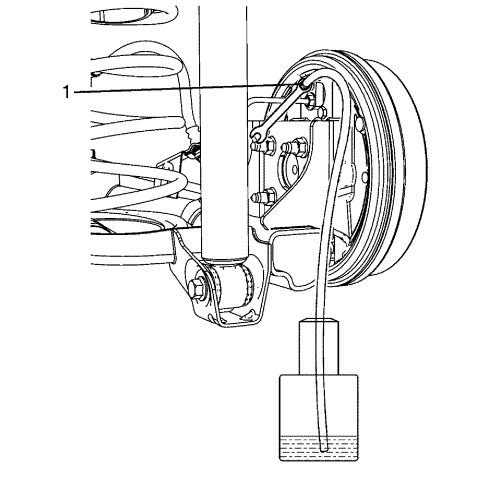Hydraulic Brake System Bleeding — Manual
Warning: Refer to Brake Fluid Irritant Warning in the Preface section.
Caution: Refer to Brake Fluid Effects on Paint and Electrical Components Caution in the Preface section.
- Place a clean workshop cloth beneath the brake master cylinder to catch brake fluid spills.
- With the ignition OFF and the brakes cool, apply the brakes 3-5 times, or until the brake pedal effort increases significantly, to deplete the brake booster power reserve.
- If you have performed brake master cylinder bench bleeding on this vehicle, or if you have disconnected the brake pipes from the proportioning valve assembly or the brake pressure modulator assembly, you MUST perform the following steps to bleed air at the ports of the hydraulic component.
| 3.1. | Fill the master cylinder reservoir to the maximum-full level with the approved brake fluid from a clean, sealed brake fluid container. |
If removal of the reservoir cap and diaphragm is necessary, clean the outside of the reservoir on and around the cap prior to removal.
| 3.2. | With the brake pipes installed securely to the master cylinder, proportioning valve assembly, or brake pressure modulator valve assembly, loosen and separate one of the brake pipes from the port of the component. |
| | Note: For the proportioning valve assembly or the brake pressure modulator valve assembly, perform these steps in the sequence of system flow; begin with the fluid feed pipes on the master cylinder. |
| 3.3. | Allow a small amount of brake fluid to gravity bleed from the open port of the component. |
| 3.4. | Connect the brake pipe fitting to the component and tighten securely. |
| 3.5. | Have an assistant slowly depress the brake pedal fully and maintain steady pressure on the pedal. |
| 3.6. | Loosen the same brake pipe fitting to purge air from the open port of the component. |
| 3.7. | Tighten the brake pipe fitting, then have the assistant slowly release the brake pedal. |
| 3.8. | Wait 15 seconds, then repeat steps 3.3-3.7 until all air is purged from the same port of each component. |
| 3.9. | With the brake pipe fitting installed securely to the master cylinder, proportioning valve assembly, or brake pressure modulator valve assembly after all air has been purged from the first port of the component that was bled, loosen and separate the next brake pipe from the component and repeat steps 3.3-3.8 until each of the ports on the component has been bled. |
| 3.10. | After completing the final component port bleeding procedure, ensure that each of the brake pipe fittings is properly tightened. |
- Fill the master cylinder reservoir to the maximum-full level with the approved brake fluid from a clean, sealed brake fluid container. Ensure the master cylinder reservoir remains at least half-full during this bleeding procedure. Add fluid as needed to maintain the proper level.
Clean the outside of the reservoir on and around the reservoir cap prior to removing the cap and diaphragm.

- Install a proper box-end wrench onto the RIGHT REAR wheel hydraulic circuit bleeder valve (1).
- Install a transparent hose over the end of the wheel hydraulic circuit bleeder valve (1).
- Submerge the open end of the transparent hose into a transparent container partially filled with the approved brake fluid from a clean, sealed brake fluid container.
- Have an assistant slowly depress the brake pedal fully and maintain steady pressure on the pedal.
- Loosen the bleeder valve to purge air from the wheel hydraulic circuit.
- Tighten the bleeder valve, then have the assistant slowly release the brake pedal.
- Wait 15 seconds, then repeat steps 8-10 until all air is purged from the wheel hydraulic circuit.
- Tighten the wheel circuit bleeder valve securely.
- Install a proper box-end wrench onto the LEFT FRONT wheel hydraulic circuit bleeder valve.
- Install a transparent hose over the end of the bleeder valve, then repeat steps 7-12.
- Install a proper box-end wrench onto the LEFT REAR wheel hydraulic circuit bleeder valve.
- Install a transparent hose over the end of the bleeder valve, then repeat steps 7-12.
- Install a proper box-end wrench onto the RIGHT FRONT wheel hydraulic circuit bleeder valve.
- Install a transparent hose over the end of the bleeder valve, then repeat steps 7-12.
- After completing the final wheel hydraulic circuit bleeding procedure, ensure that each of the 4 wheel hydraulic circuit bleeder valves is properly tightened.
- Fill the brake master cylinder reservoir to the maximum-full level with the approved brake fluid from a clean, sealed brake fluid container.
- Slowly depress and release the brake pedal. Observe the brake pedal feel.
- If the brake pedal feels spongy, repeat the bleeding procedure again. If the brake pedal still feels spongy after repeating the bleeding procedure, perform the following steps:
| 22.2. | Pressure bleed the hydraulic brake system in order to purge any air that may still be trapped in the system. |
- Turn the ignition ON, with the engine OFF. Check to see if the brake system warning lamp remains illuminated.
Note: DO NOT allow the vehicle to be driven until it is diagnosed and repaired.
- If the brake system warning lamp remains illuminated, refer to Symptoms - Hydraulic Brakes .
| © Copyright Chevrolet. All rights reserved |
